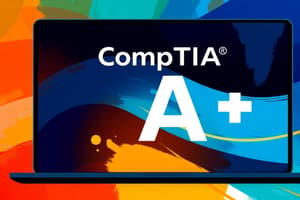Podcast
Questions and Answers
What is the main purpose of clock speed in a CPU?
What is the main purpose of clock speed in a CPU?
- It indicates how fast a CPU can process data. (correct)
- It measures the total storage capacity of a CPU.
- It determines the number of cores in a CPU.
- It defines the thermal output of the CPU.
What does a 64-bit CPU allow in terms of memory compared to a 32-bit CPU?
What does a 64-bit CPU allow in terms of memory compared to a 32-bit CPU?
- It offers faster processing for 32-bit software.
- It can address up to 16 Terabytes of RAM. (correct)
- It can address up to 4 Gigabytes of RAM.
- It is limited to using 32-bit operating systems.
Which statement best describes BGA sockets used in laptops?
Which statement best describes BGA sockets used in laptops?
- They are exclusively used for desktop CPUs from Intel and AMD.
- They support easy upgrades for additional RAM.
- They utilize solder balls to permanently attach the CPU to the board. (correct)
- They have removable connectors for easy CPU replacement.
What is Hyper-Threading in relation to CPU technology?
What is Hyper-Threading in relation to CPU technology?
What purpose do the USB pin headers serve on a motherboard?
What purpose do the USB pin headers serve on a motherboard?
Which of the following operating systems can be run on both 32-bit and 64-bit architectures?
Which of the following operating systems can be run on both 32-bit and 64-bit architectures?
Which component is responsible for initiating the boot process in a computer system?
Which component is responsible for initiating the boot process in a computer system?
What functionality does Secure Boot provide in UEFI?
What functionality does Secure Boot provide in UEFI?
What type of memory is used to store the BIOS/UEFI configuration?
What type of memory is used to store the BIOS/UEFI configuration?
Which power connector is typically used for CPU power in modern motherboards?
Which power connector is typically used for CPU power in modern motherboards?
What is the primary function of chassis fans in a computer case?
What is the primary function of chassis fans in a computer case?
What type of connector is commonly used for CPU fans?
What type of connector is commonly used for CPU fans?
What is the role of the CMOS in relation to the BIOS/UEFI?
What is the role of the CMOS in relation to the BIOS/UEFI?
What is the primary function of a Site-to-Site VPN?
What is the primary function of a Site-to-Site VPN?
Which layer of Software-Defined Networking (SDN) is responsible for communicating instructions to network devices?
Which layer of Software-Defined Networking (SDN) is responsible for communicating instructions to network devices?
What does the exclusion range in DHCP indicate?
What does the exclusion range in DHCP indicate?
What is a benefit of using IP reservations in DHCP?
What is a benefit of using IP reservations in DHCP?
In the 4-step DHCP process, what message is sent from the client to the server during the Request phase?
In the 4-step DHCP process, what message is sent from the client to the server during the Request phase?
Which interface in SDN is used for communication between the controller and network devices?
Which interface in SDN is used for communication between the controller and network devices?
What is an example of an application that can operate within the Application Layer of SDN?
What is an example of an application that can operate within the Application Layer of SDN?
What defines the duration for which an IP address is assigned to a host in DHCP?
What defines the duration for which an IP address is assigned to a host in DHCP?
What is the primary purpose of RAM in a computer?
What is the primary purpose of RAM in a computer?
What type of memory retains data even when the power is off?
What type of memory retains data even when the power is off?
What function does the motherboard serve in a computer system?
What function does the motherboard serve in a computer system?
Which cooling method is most commonly used in computers?
Which cooling method is most commonly used in computers?
What is the primary role of a computer's PSU?
What is the primary role of a computer's PSU?
How does the chipset of a motherboard impact system capabilities?
How does the chipset of a motherboard impact system capabilities?
Which of the following is NOT considered an input device?
Which of the following is NOT considered an input device?
What percentage of the Core 1 exam focuses on Mobile Devices?
What percentage of the Core 1 exam focuses on Mobile Devices?
What is the passing score required for the Core 2 exam?
What is the passing score required for the Core 2 exam?
Which computer type is designed for portability and convenience?
Which computer type is designed for portability and convenience?
What is the function of thermal compounds in passive cooling?
What is the function of thermal compounds in passive cooling?
Which cooling technique utilizes moving parts?
Which cooling technique utilizes moving parts?
What is a key consideration when using an all-in-one liquid cooler?
What is a key consideration when using an all-in-one liquid cooler?
What should be done before installing a heat sink?
What should be done before installing a heat sink?
How do case fans contribute to system cooling?
How do case fans contribute to system cooling?
What is true about thermal pads compared to thermal compounds?
What is true about thermal pads compared to thermal compounds?
What is a potential risk of liquid cooling systems?
What is a potential risk of liquid cooling systems?
Which calculation accurately represents CPU frequency?
Which calculation accurately represents CPU frequency?
Flashcards
Core 1 Exam (220-1101)
Core 1 Exam (220-1101)
Focuses on hardware topics, requires a passing score of 675.
Core 2 Exam (220-1102)
Core 2 Exam (220-1102)
Centers on software topics, requires a passing score of 700.
Exam time limit
Exam time limit
Each CompTIA A+ exam lasts 90 minutes.
Mobile Devices domain
Mobile Devices domain
Signup and view all the flashcards
Networking domain
Networking domain
Signup and view all the flashcards
RAM
RAM
Signup and view all the flashcards
HDD
HDD
Signup and view all the flashcards
SSD
SSD
Signup and view all the flashcards
Power Supply
Power Supply
Signup and view all the flashcards
Air Cooling
Air Cooling
Signup and view all the flashcards
Liquid Cooling
Liquid Cooling
Signup and view all the flashcards
CPU
CPU
Signup and view all the flashcards
Motherboard
Motherboard
Signup and view all the flashcards
Chipset
Chipset
Signup and view all the flashcards
BIOS/UEFI
BIOS/UEFI
Signup and view all the flashcards
Clock Speed
Clock Speed
Signup and view all the flashcards
32-bit vs 64-bit
32-bit vs 64-bit
Signup and view all the flashcards
Multithreading
Multithreading
Signup and view all the flashcards
Passive Cooling
Passive Cooling
Signup and view all the flashcards
Active Cooling
Active Cooling
Signup and view all the flashcards
DHCP
DHCP
Signup and view all the flashcards
DHCP Process
DHCP Process
Signup and view all the flashcards
Input Devices
Input Devices
Signup and view all the flashcards
Output Devices
Output Devices
Signup and view all the flashcards
Ports
Ports
Signup and view all the flashcards
Expansion Cards
Expansion Cards
Signup and view all the flashcards
Form Factor
Form Factor
Signup and view all the flashcards
Network Services
Network Services
Signup and view all the flashcards
Study Notes
CompTIA A+ Exam Overview
- Core 1 Exam (220-1101): Focus on hardware, passing score = 675 (75%), cost = $253 in the USA.
- Core 2 Exam (220-1102): Focus on software, passing score = 700 (78%), cost = $253 in the USA.
- Each exam has a 90-minute time limit and up to 90 questions in formats including multiple choice, drag & drop, and performance-based.
Core Domains
- Core 1 Domains:
- Mobile Devices: 15%
- Networking: 20%
- Hardware: 25%
- Virtualization & Cloud Computing: 11%
- Hardware and Network Troubleshooting: 29%
- Core 2 Domains:
- Operating Systems: 31%
- Security: 25%
- Software Troubleshooting: 22%
- Operational Procedures: 22%
Computer Types
- Desktop: Tower, Mini PC, All-in-One
- Mobile: Laptop, Desktop Replacement, Ultra Portable, Tablet, Smart Phone, Thin Client, Netbook, IoT Device
Memory & Storage
- RAM (Random Access Memory):
- Fast access, volatile memory, data lost when power off.
- Storage Options:
- HDD (Hard Disk Drive): Traditional, slower.
- SSD (Solid State Drive): Newer, faster, non-volatile.
Power Supply & Cooling
- Power Supply:
- Internal for desktops, external for laptops, converts AC to DC.
- Cooling Methods:
- Air Cooling: Most common, uses fans.
- Liquid Cooling: For specialized applications, effective but more complex.
CPU and Motherboard
- CPU (Central Processing Unit):
- "Brains" of the computer, mounted on the motherboard, requires a heat sink and fan for cooling.
- Motherboard:
- Connects all components, provides power to CPU and RAM, facilitates data communication.
Ports and Expansion
- Ports integrated on the motherboard for audio, video, network connections, and USB.
- Expansion Cards:
- Provide additional ports and capabilities beyond what the motherboard offers.
Input and Output Devices
- Input Devices: Keyboard, mouse, trackball, touchpad, touchscreen.
- Output Devices: Monitor, speakers, printers, network connections.
Motherboard Components
- Chipset: Defines CPU compatibility, RAM specifications, port types, and storage capabilities.
- Form Factor: Determines size but not performance.
- Connectors and Pin Headers: Include USB, power, and fan connectors.
BIOS/UEFI
- BIOS/UEFI initializes boot process and manages hardware features.
- ROM and EEPROM store BIOS/UEFI, allowing for updates to improve compatibility and security.
- UEFI features include Secure Boot and improved startup times.
CPU Technology
- Clock Speed: Measure of performance, faster processors are rated in GHz.
- 32-bit vs 64-bit:
- 64-bit systems can utilize more RAM (16 TB vs 4 GB).
- Multithreading: Enhanced processing capabilities, Hyper-Threading for Intel CPUs.
Cooling Methods
- Passive Cooling: Uses no moving parts (e.g., heat sinks).
- Active Cooling: Uses fans, both CPU and case fans for managing airflow.
- Liquid Cooling: Uses liquids for heat transfer, requires careful installation and maintenance.
Network Services: DHCP
- DHCP assigns IP configurations, defines scopes and leases.
- Key DHCP Process Steps:
- Discover Broadcast
- Offer Unicast
- Request Broadcast
- Acknowledge UniCast
Studying That Suits You
Use AI to generate personalized quizzes and flashcards to suit your learning preferences.




